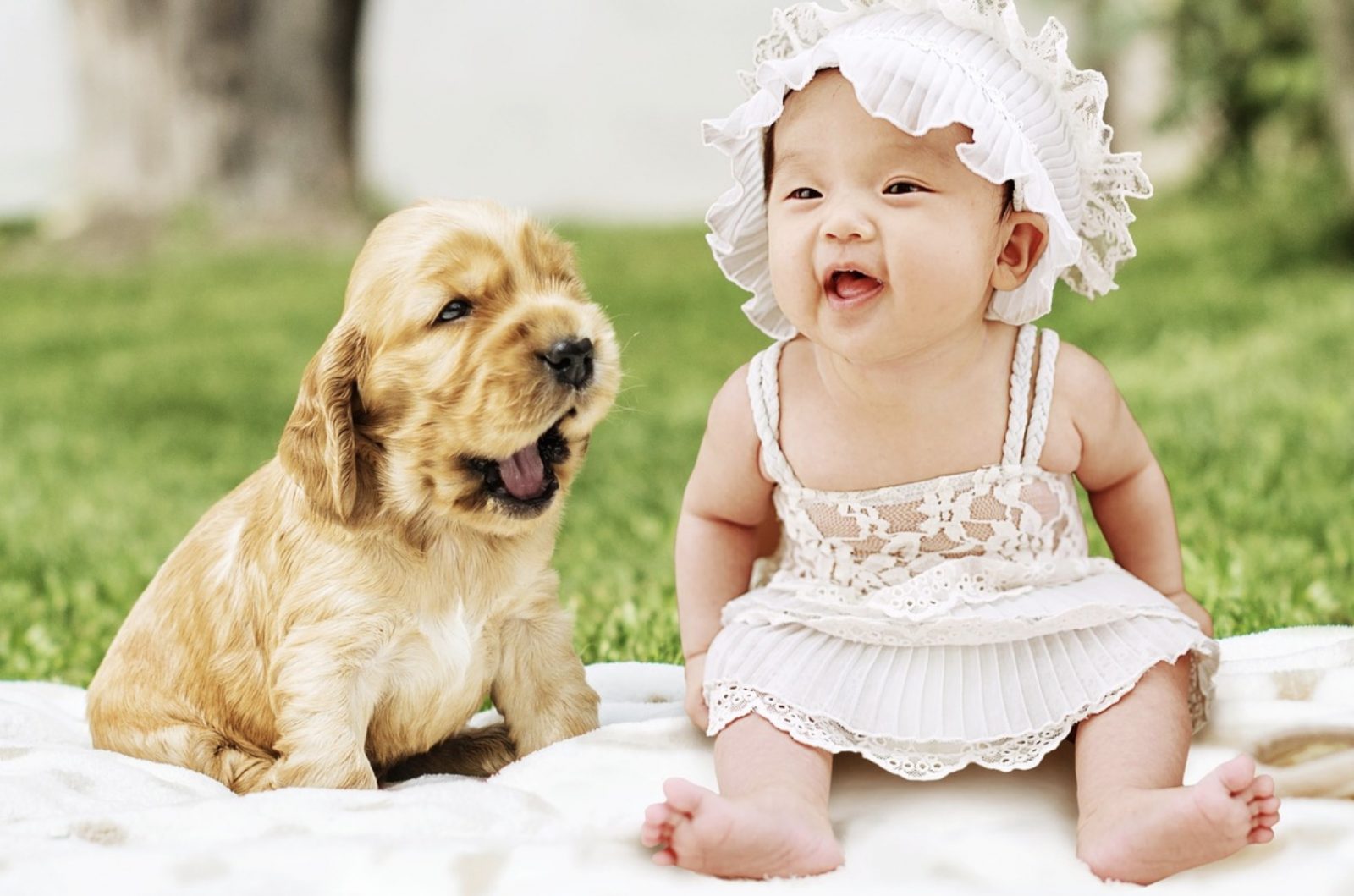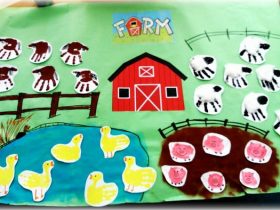If you are a dog owner who is expecting a new baby, you probably have thousands of thoughts in your mind. How to bring your new baby home? What will that mean for your dog? Well, we have to warn you, bringing your baby home might get overwhelming for your puppy because of the number of novel sights, sounds, and smells. How to introduce dog to baby safely?
Today, we will talk about how to make this introduction as smooth as possible for everyone. You need to prepare your fur baby for the arrival of your child.
There are two things you need to know as a pet parent. First, you need to teach your dog the skills necessary for interaction with the new family member. And second, help your puppy adjust to the new experience and changes.
Reader's Roadmap
Will my baby be safe around my dog?
It is natural and logical to ask yourself whether your newborn baby will be safe around your dog. Now, most dogs happily welcome new additions to the family. Yet, there should always be precautions.
If you have trained and socialized your dog properly, there will be no problems when you bring a new family member to the home.
Your dog must respond to all your cues and commands before you bring a new life home. And when you bring your young child home, try not to upset your dog’s routine too much. Remember, dogs are addicted to routine. Continue to greet your dog and reward it for good behavior.
Do breeds matter?
You may find articles best dog breeds for babies and so on. But you should not assume that your dog might pose a problem or not pose a problem depending on breed alone.
Babies have been bitten by a Rottweiler, but also by a Chihuahua and Labrador. The breed should not be the only factor when planning to increase your family with a baby.
How to make a plan?
Your family dog will benefit from dog training that you can do before you bring a baby home. Here are some ideas you can implement and start making plans for increasing your family.
Start by teaching your dog some basic obedience skills like sit, stay, lie down, and so on. You need to teach your dog about some specific situations.
Four months before your baby arrives, you can gradually introduce your dog to the new experiences, sights, sounds, and smells they might encounter. Associate these new things with rewards.
One or two months before the baby arrives, you can start planning for changes to your dog’s daily routine.
This is probably the most important aspect of how to introduce dog to baby. Your dog has one routine, and any changes might cause anxiety. Things will change with the arrival of the baby, but you can minimize the stress of your fur baby by gradually adding changes.
Planning and practicing changes
Let’s be honest. Nobody can predict how the schedule will work when the baby comes home. But you can begin a slow transition toward a new schedule.
For example, if your idea is to take a nap in the afternoon while the baby is sleeping, start taking afternoon naps. If you plan to walk your dog at different times of the day, gradually switch to the new routine.
Yes, life with a baby can be hectic and unpredictable. But you can prepare your dog for a less consistent daily schedule.
For starters, you can vary the time you feed your dog. Let’s say your dog gets breakfast at 7 am sharp, and dinner at 8 pm. Well, a month before your baby comes home, start feeding your dog breakfast at random times between 6 am and 7 am, and dinner between 7 pm and 8 pm. You can also get an automatic feeder that has a built-in timer, but feeding time is time for bonding with your pet.
There is one mistake a lot of dog owners make. As a pet parent expecting a baby, they lavish their dog with extra attention before the baby’s due date. But this will set your dog up for a big letdown when the baby arrives and takes the center stage.
What can you do instead? Start scheduling short play and cuddle sessions with your puppy, and give your dog less and less attention at other times of the day. Schedule these sessions randomly so that your dog doesn’t expect attention at a particular time.
Baby and Dog First Meeting
Before you bring your baby home, you can prepare your family dog for the new member. Bring an item that contains your baby’s scent, for example, a burp cloth, from the hospital before you bring baby home.
The most important thing during this exercise is to set boundaries. That means challenging your dog to sniff the item from a distance. Reward your dog when they sniff from a distance. The goal here is to teach your dog that the item is yours and that you are the one giving permission for the dog to sniff.
Bringing your baby home
We all know first impressions are quite important. That applies to a job interviews, date nights, and everything in between. Your dog should have a pleasant experience with your newborn baby from the start. How to do that?
Well, one way to do it is to send everyone else in the house first before you come back from the hospital. This way, your dog can express its excitement around people. After a minute or two of greeting other people, have a family member leash your dog. Give that member some treats to use during the first few moments with the baby.
Make sure your dog is calm and relaxed when the baby enters the house. So no zoomies, no playing, no nervous behavior, no jumping, and so on. You can have the family member distract your dog with treats so that her attention is divided between the treats, the baby, and the people in the home.
Meeting the baby
Some people allow their dog to investigate the baby right away. Others wait until a later time. In any case, you have to orchestrate the event carefully. For this exercise, choose a quiet room. Sit down with the baby in your arms, and have someone bring the dog to the room.
Avoid nervous or anxious behavior. Before your dog approaches the baby, talk to it with a calm and happy voice. Invite your puppy to approach your new baby. It is your job to convince the dog that meeting and interacting with the new family member will be fun, not stressful.
Watch your dog’s body language. If it is relaxed and friendly, have the family member walk the dog toward you and the baby. It is natural for parents to feel anxious and nervous about letting their dog close to the infant. But be careful not to show nervousness. Remember, dogs pick up on our feelings. If you are nervous, your dog will be too and react accordingly.
Let your dog sniff the baby, but then gently interrupt the investigation by praising your dog and asking to sit down or lie down. Reward for compliance with tasty dog treats.
Teach your dog to love the baby
After you are done with the first meeting, it is now time to work on the relationship between your little one and your pet. Continue to associate good things happening when your baby is around your dog.
Try not to fall into the obvious trap of a pet parent. That is giving your dog attention when the baby is sleeping, and then ignoring them when the baby is awake. You can do the opposite instead. Give your canine friend attention when the baby is awake.
You can also take your baby along when you walk your dog. Yes, that might be too much of a hassle. But a stroller and a leash will get the job done, right?
One neat trick to make sure your dog loves the baby. When the baby is not around, try to make things as boring as possible. Try to ignore your dog then, and this will make your puppy eager and anticipate the baby’s next active time.
Encourage quiet time together
Living with a baby and a puppy can be hectic, right? You need some quiet time. Well, it is your job to encourage that.
Teach your dog to settle down when the baby is asleep. Or you can keep a dog bed in the room where you feed the baby. Provide something tasty for the dog, like a chew dog toy when you are feeding the baby.
Or reward with dog treats when the dog is in a stay position for long periods while you feed the baby.
Teaching polite manners
The trick is to reward your dog for calm behavior and good behavior when the baby is around. This will help your dog understand that only good behavior around the baby gets rewarded.
Encourage calm behavior that will pay off in the weeks and months ahead.
Teach your child to respect the dog
The dream for any parent who has a dog is for the baby and dog to play together. But you have to make sure your child respects your dog as well.
As your little one develops, teach him to respect the body and safe zones of the dog. Show your child what gentle and enjoyable petting looks like. You can teach your baby to stoke and scratch your dog in its favorite spots.
You can play games with your dog and baby, but we do not recommend these until your young child is at least two years of age.
And once your baby starts speaking, you can teach them to tell the dog commands like sit and lie down. Praise the compliance of your puppy.
Poking the puppy
You cannot expect your baby to be perfect when touching your dog. What you can do is prepare your puppy for some pokes. Use small and delicious treats to reward your dog for tolerating every uncomfortable sensation.
Of course, make sure there are not many pokes. But you should always prepare. Dedicate some time each day to practice touching your dog. Some areas you can try include the side or rump. Touch the side, and then give a treat. Then repeat poking a few times, and then give a treat. Then move to the ear, touch the ear, and give a treat. Pinch your dog, and then give it a treat.
Practice these uncomfortable touches so that your dog will not react when the baby accidentally touches it.
Practice baby movements
Your dog probably has never seen a baby crawl. It might be an intimidating experience for your dog. Crawling puts a person right at the eye level of dogs. It is a good idea to get your dog used to crawling before your baby actually starts doing it.
Movement and mobility are big achievements for your little one. And you want your dog to be joyful about it as well.
How to practice? Well, you can crawl toward your dog. Pet your dog as it lifts its head and then give treats.
Teach your dog to retreat
Your dog might not know it, but it can safely retreat and move away from your baby. If your dog feels tired, nervous, anxious, or anything in between, it should be allowed to move away.
It is a much better option than growling at the baby. When your dog is put in a corner, it might snap and react. And you do not want that.
How to make sure your baby and dog get along
Now that we talked about how to introduce dog to baby, let’s go over some final hints about how to help them get along.
- Include your dog in baby-related activities and let it sit nearby. For example, when you are changing a diaper
- Talk to both your baby and dog
- Stock up on playthings, as long as your puppy has its own dog toy to chew, it will not use a baby toy
- Avoid food fights by keeping your dog’s bowls on the counter when it is not time for feeding
- Teach your baby to be gentle as it begins exploring with her hands
Always supervise
At the end of the day, no matter how confident you are in your dog, do not let your puppy and baby play without supervision. During your child’s exploratory state, you must supervise interactions between the two family members.
Last, but not least, do not forget the dog. Provide daily walks and consistent leadership. Do not make your dog feel left out.







Leave a Reply
View Comments